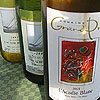
 Nova Scotia’s wine industry rarely gets the attention it deserves. Though the climate is cool, several distinct grape-growing regions exist, with the Annapolis Valley as the historic home of viticulture.
Nova Scotia’s wine industry rarely gets the attention it deserves. Though the climate is cool, several distinct grape-growing regions exist, with the Annapolis Valley as the historic home of viticulture.
The valley has the warmest summer temperatures and benefits from low precipitation levels. It’s here that Roger Dial, one-time managing partner of California’s Davis Bynum Winery, pioneered the Nova Scotia wine industry in the late 1970s with his Grand Pré Winery. After trials with upwards of a 100 varieties from around the world, Grand Pré championed the ecologically suited varietals, L’Acadie Blanc and New York Muscat, as well as the Vitis amurensis varieties Michurinetz and Saperavi Severnyi. The original winery, now known as Domaine de Grand Pré, is owned by Swiss interests.
The province's Northumberland Shore offers an entirely different sort of microclime which has been the viticultural focal point of the Jost family since the late 1970s. The Josts opened their winery in 1983 and are now the province’s largest winery, with an exciting program of encouraging contract growers to explore unique microclimates across the province.
Two other Annapolis Valley wineries, Sainte Famille and Blomidon Ridge, both of which began as Grand Pré contract growers in the early 1980s, have joined the originals, and other vineyards-turning-wineries will soon be opening on the province's South Shore and Gaspereau Valley. A strong fruit wine industry also exists in the province. Four wineries produce a range of products from fruit sourced in the region.
|
|
Current Feature
In the southern Blue Ridge Mountains of North Carolina and Georgia vineyards are small and few, yet the establishment of the Upper Hiwassee Highlands could bring much more.
[>] continue
Appellation Features
[>] see all Nova Scotia features (9)
Related Features
Alive & Well here

Baco Noir:
Abandoned by the French, you seem
to have found a home in some chilly
vineyards. Tannic
[>] continue
Correspondent
 Craig Pinhey
Craig Pinhey
is the Regional Correspondent for Nova Scotia.



 Bi-State Upper Hiwassee Highlands an AVA
Bi-State Upper Hiwassee Highlands an AVA  A Bridge Not Too Far
A Bridge Not Too Far  A Sparkling Future for L'Acadie Vineyards
A Sparkling Future for L'Acadie Vineyards  Sean Wood's "Wineries & Wine Country of Nova Scotia" just released
Sean Wood's "Wineries & Wine Country of Nova Scotia" just released  Bear River: Appellation in the making
Bear River: Appellation in the making 
 Gaspereau Vineyards Opens its Doors
Gaspereau Vineyards Opens its Doors  Remote Manton Valley New California AVA
Remote Manton Valley New California AVA WAWGG Banquet Explores Washington State Terrior
WAWGG Banquet Explores Washington State Terrior




